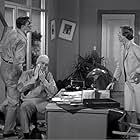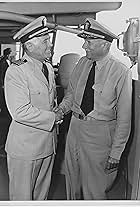Documentary dramatic anthology about the US Navy's submarine fleet. All stories were based on fact and the realism was heightened by actual use of combat footage from the files of the Navy.Documentary dramatic anthology about the US Navy's submarine fleet. All stories were based on fact and the realism was heightened by actual use of combat footage from the files of the Navy.Documentary dramatic anthology about the US Navy's submarine fleet. All stories were based on fact and the realism was heightened by actual use of combat footage from the files of the Navy.
Browse episodes
Photos
Storyline
Did you know
- TriviaDocumentary dramatic anthology about the U.S. Navy's submarine fleet.
Featured review
I did something for this title I never do. I gave it ten out of ten. It's not that this series was that brilliant an example of television art. It wasn't. It was a classic 1950's-vintage low-budget (very low budget) B-grade syndicated half-hour black-and-white TV show of a kind that has become practically non-existent on commercial TV for nearly fifty years now. For a person looking at this for television art perhaps its highest value is as an excellent example of what TV looked like so often in the first decade of the medium.
No, the reason I gave it ten out of ten is that it is about as genuine a dramatized account of the American submarine effort in World War II as anybody is ever likely to make, and that effort, as the name of the series implies, has been generally unsung. The submarine force picked up the nickname "silent service" during the war (like with so many other things, the phrase was popularized if not actually coined by the news media of the day) because the submarine force officialdom as well as individual submariners simply would not talk publicly about what they were doing except on infrequent and carefully controlled occasions.
This originated not out of some social or organizational misanthropy or sense of elitism, but for security reasons. The story goes that early in the war the submarine service was as forthcoming as any other combat branch of the US armed forces, but that when too much information showed up in the media Japanese intelligence agents collected it and sent it to Japan, affording them a significant improvement in the tactics they used in hunting and sinking our submarines. Thus (and no pun intended), the force and its personnel promptly clammed up for the duration.
But by the 1950's there was no need to maintain that kind of secrecy and the story the submariners could not tell before could finally come out. It turned out that although the submarine force comprised only about 2% of the Navy's total personnel, acting alone it had sunk approximately 30% of all Japanese warships eliminated during the war. At the same time it was doing that, it also was responsible for over 50% of all Japanese commercial ships sunk during the war, totaling 6,000,000 tons of shipping, or the equivalent of the entire prewar Japanese merchant marine. No less a luminary than Fleet Admiral William F. "Bull" Halsey (who was a destroyer man and eventually gained his great fame as a naval aviation admiral, and was never a submariner), once stated: "(i)f I had to give credit to the instruments and machines that won us the war in the Pacific, I would rate them in this order: submarines first . . . " The cost had been high: 52 submarines lost, and about 20% of all submariners killed, the highest mortality rate of any combat branch of any of the services in the war. Neither the Marines nor the paratroopers nor the bomber crews nor any other community in the five services (the US Coast Guard included) had so oppressive a death rate.
Thus I give this series the highest possible IMDb rating for finally getting this out to the public, one submarine's story at a time for as long as its short run allowed, and moreover I especially laud this series for its decided LACK of Hollywood flair, at least in the earlier episodes. In the series description on the IMDb front page for this show it says its realism was enhanced by the usage of some actual wartime combat footage, but the truth is that what enhanced its realism is the fact that it was not made by the usual Hollywood glitz and glamor crowd but by an actual former submarine commander. This not only not only enhanced the realism of the story details and the action in general, but ensured that the factual content was as close to 100% accurate as time and resources constraints would allow, holding the dramatic license factor to a minimum, even if there was increasing amounts of the hokey melodrama thought necessary to make the show appealing to a general audience as the series production run went on over time. The use of then mostly-unknown actors (although many of them would become very well-known in years to follow, one of the fun things about this series) contributed to this tone, and, finally, the appearance of "special guests" who were the actual submarine officers involved in the event depicted, was invaluable. Would that there were more such patently ingenuous dramatizations of real-life naval or military operations as this.
NOTE: unaccountably, IMDb still won't let posters use the correct "box" brackets used in normal writing in appropriate places, and I am forced to use normally inappropriate parentheses in their place out of necessity. It is regrettable that the programmers who do this site force this kind of illiteracy on their audience. I was never a C-student in language arts classes and I don't appreciate being made to look like one through no fault of my own. Maybe these people need to be sent back to junior high school to repeat their seventh-grade English classes.
No, the reason I gave it ten out of ten is that it is about as genuine a dramatized account of the American submarine effort in World War II as anybody is ever likely to make, and that effort, as the name of the series implies, has been generally unsung. The submarine force picked up the nickname "silent service" during the war (like with so many other things, the phrase was popularized if not actually coined by the news media of the day) because the submarine force officialdom as well as individual submariners simply would not talk publicly about what they were doing except on infrequent and carefully controlled occasions.
This originated not out of some social or organizational misanthropy or sense of elitism, but for security reasons. The story goes that early in the war the submarine service was as forthcoming as any other combat branch of the US armed forces, but that when too much information showed up in the media Japanese intelligence agents collected it and sent it to Japan, affording them a significant improvement in the tactics they used in hunting and sinking our submarines. Thus (and no pun intended), the force and its personnel promptly clammed up for the duration.
But by the 1950's there was no need to maintain that kind of secrecy and the story the submariners could not tell before could finally come out. It turned out that although the submarine force comprised only about 2% of the Navy's total personnel, acting alone it had sunk approximately 30% of all Japanese warships eliminated during the war. At the same time it was doing that, it also was responsible for over 50% of all Japanese commercial ships sunk during the war, totaling 6,000,000 tons of shipping, or the equivalent of the entire prewar Japanese merchant marine. No less a luminary than Fleet Admiral William F. "Bull" Halsey (who was a destroyer man and eventually gained his great fame as a naval aviation admiral, and was never a submariner), once stated: "(i)f I had to give credit to the instruments and machines that won us the war in the Pacific, I would rate them in this order: submarines first . . . " The cost had been high: 52 submarines lost, and about 20% of all submariners killed, the highest mortality rate of any combat branch of any of the services in the war. Neither the Marines nor the paratroopers nor the bomber crews nor any other community in the five services (the US Coast Guard included) had so oppressive a death rate.
Thus I give this series the highest possible IMDb rating for finally getting this out to the public, one submarine's story at a time for as long as its short run allowed, and moreover I especially laud this series for its decided LACK of Hollywood flair, at least in the earlier episodes. In the series description on the IMDb front page for this show it says its realism was enhanced by the usage of some actual wartime combat footage, but the truth is that what enhanced its realism is the fact that it was not made by the usual Hollywood glitz and glamor crowd but by an actual former submarine commander. This not only not only enhanced the realism of the story details and the action in general, but ensured that the factual content was as close to 100% accurate as time and resources constraints would allow, holding the dramatic license factor to a minimum, even if there was increasing amounts of the hokey melodrama thought necessary to make the show appealing to a general audience as the series production run went on over time. The use of then mostly-unknown actors (although many of them would become very well-known in years to follow, one of the fun things about this series) contributed to this tone, and, finally, the appearance of "special guests" who were the actual submarine officers involved in the event depicted, was invaluable. Would that there were more such patently ingenuous dramatizations of real-life naval or military operations as this.
NOTE: unaccountably, IMDb still won't let posters use the correct "box" brackets used in normal writing in appropriate places, and I am forced to use normally inappropriate parentheses in their place out of necessity. It is regrettable that the programmers who do this site force this kind of illiteracy on their audience. I was never a C-student in language arts classes and I don't appreciate being made to look like one through no fault of my own. Maybe these people need to be sent back to junior high school to repeat their seventh-grade English classes.
- How many seasons does The Silent Service have?Powered by Alexa
Details
- Runtime30 minutes
- Color
- Aspect ratio
- 1.33 : 1
Contribute to this page
Suggest an edit or add missing content





























